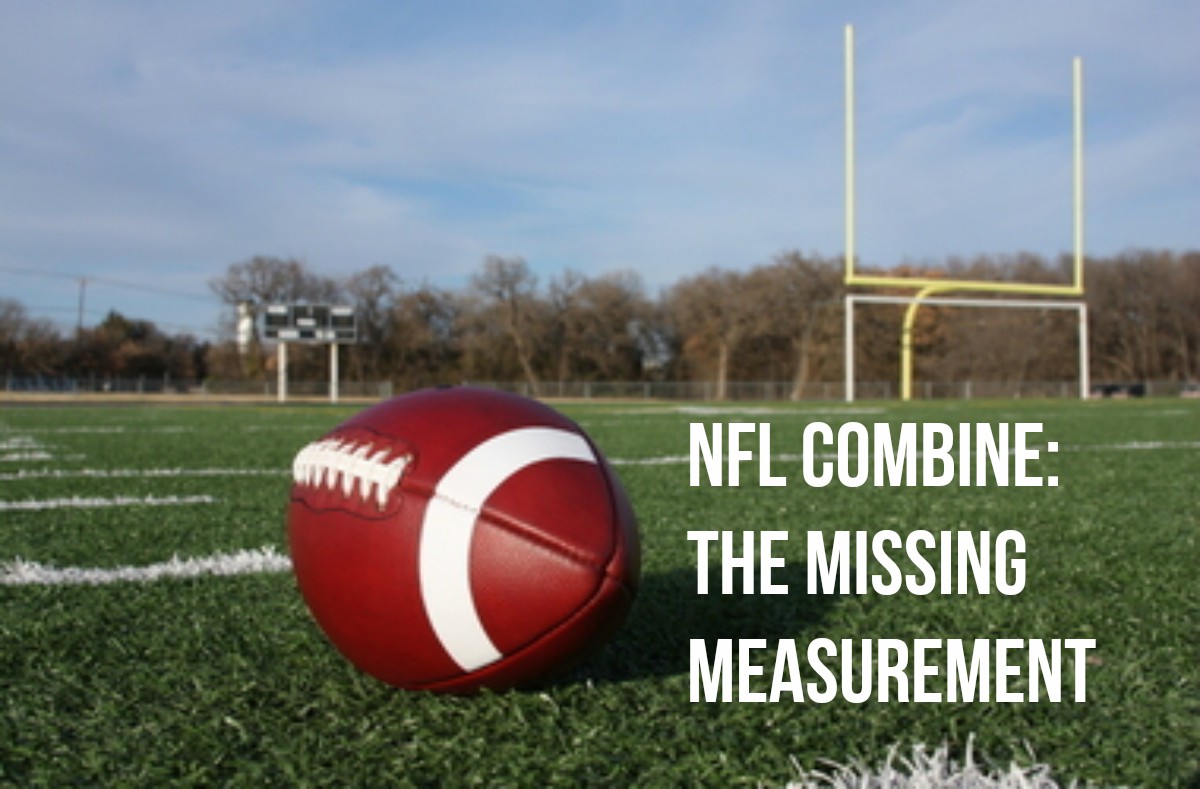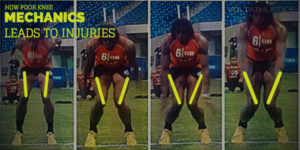NFL Combine: The Missing Measurement

On April 27th, your favorite football team will be selecting a young man to change the face of your franchise and lead your suffering city back to the promised land. That is unless you are a Browns fan and your team selects the “sleeper” pick that hits the snooze button on the championship parade.
Over the next week, draft experts will engage in endless hyperbole about each prospect’s game film, college statistics, scouting reports, and combine numbers. Millions of dollars and countless careers depend on selecting the correct player. Teams will trade away proven players on their roster and pay millions of dollars more to gamble and select a player a few picks earlier in the draft. All the while, statistical researchers Cade Massaey and Richard Thaler did a formal study concluding that the chances that a drafted player will turn out to be better than the next player in his position drafted is only 52%. Which essentially is no better than a coin flip.
The intangibles that made players like Tom Brady and Antonio Brown great are near impossible to measure. However, something that often gets overlooked in all the madness of a 40-yard dash and 20-yard shuttle time is how an athlete moves biomechanically and how this may predispose the athlete to a devastating injury. While selecting the next NFL superstar is an imperfect science, determining the injury risk of any athlete can be much more precise.
BIOMECHANICS
Why do so many professional athletes have their careers cut short due to preventable knee injuries? One of the main reasons is a term I will repeatedly mention in this article: biomechanics.
What is biomechanics? Biomechanics in sports can be defined as the muscular, joint, and skeletal actions of the body during the execution of a given task, skill, and/or technique.
For example, let’s take a look at RG3′s vertical jump. While his vertical jump measurements are off-the-charts, his biomechanics are not sound. Notice how his knees collapse inward during the downward phase of his squat before propelling upward to jump.
*Picture taken from: https://plus.google.com/+Behmmjc/posts/bnZ8SshmXgG
This, my friends, is called valgus knee collapse and it is very bad. How the Washington Redskins scouting department ignored it is beyond me.
KNEE VALGUS
A year after RG3′s breakout rookie season with Washington, he tore his ACL, LCL, and meniscus in his right knee. An important caveat is that this was a result of a non-contact injury. Meaning there was no accidental or unexpected force that caused his ligaments to tear.
RG3 originally tore his ACL a few years earlier while playing at Baylor. In terms of biomechanics, repetitive valgus knee collapse can lead to injuries no matter what type of athlete you are. The laundry list of common ailments includes patellofemoral pain, IT band syndrome, and, you guessed it… ACL tears.[1][2][3][4] Most likely, RG3′s catastrophic knee injury didn’t start on the field—it started years earlier in the weight room. Ignoring important knee stabilizers and your big gluteal muscles when strength training reinforces your body’s compensatory movement patterns and predisposes you to injury. And it is not as simple as going to the gym and strengthening your legs. This is because you are probably just strengthening your body’s preferred pattern of muscle recruitment and reinforcing isolation of certain muscles like your quads.
Every single person has a “motor pattern” that favors and repeatedly strengthens certain muscles and ignores others.[5] Have you ever worked out with someone who asks, “Do you feel this exercise here?” The response will usually be a resounding “no.”
WHY DOESN’T HE JUST STOP DOING THAT?
For clarification, I am not implying at all that RG3 is not superhumanly-strong or gifted in his ability to quickly turn on muscles to create the explosive power we have all seen. What I am saying is that his body’s motor pattern- the way his nervous system selects certain muscles to perform certain actions or movements- is not efficient and places excessive stress on his knees.
One could venture to say that his hip adductors (inside thigh muscles), bicep femoris (outside hamstring muscle), TFL, and/or quadratus lumborum (located in your low back) are over dominant. When a muscle dominates the movement pattern an imbalance occurs. When a muscle imbalance exists, some muscles are short (overactive) and others are long (underactive). When muscles are incapable of firing correctly due to being an inappropriate length, compensation occurs, causing your body to deviate from its normal path of motion.
As a result of RG3’s preferred motor pattern, his gluteus medius muscle located in his rear end is not being “selected” or turned on enough to prevent this knee collapse. Your gluteus medius is the main muscle responsible for hip abduction, bringing your leg and thus your knee outward. So if this muscle is weak, or, more likely, it is not being recruited to turn on during certain movements like squatting or pivoting, his knees will collapse inward. [5] HOW DO YOU CHANGE YOUR MOVEMENT PATTERNS?
One of the first things you should do is to identify your flexibility limitations. Poor flexibility leads to either a passive or active insufficiency, causing your body to recruit certain muscles vs others. Which muscles get recruited often depends on each individual’s flexibility deficits. Most men go straight to the weights in the gym and ignore this crucial part of strength training. [5,6,7] Think about the logic of sitting in a chair in one position all day at work causing all your joints and muscles to tighten up, and loading those joints with excessive amounts of force from weights. Unless you work in the Browns’ front office, you can understand that sitting all day causes your hip flexors to tighten up. If your hip flexors are tight, your abdominal and gluteal muscles are passively insufficient and shut down. These are some of your most essential stabilizing muscles.
Going back to RG3, I would argue that telling him to just perform static stretching of his tight muscles is not enough. Certain muscles are tight not because the muscle is not long enough but because the tissue itself does not have enough tissue elasticity (stretchiness). Individuals will often apply static pressure using a foam roll as another method to release their restrictions. However, this method is not often sufficient.
Instead, one of the best ways to release these restrictions in the muscle and fascia is through a method called an active release. Increased tissue tension is required to break up these adhesions and the most optimal way to do so is by actively moving your leg in a certain direction while applying pressure on a given tissue. These adhesions are very resilient and are incredibly difficult to loosen up by just pressing on it. Imagine trying to break up a piece of bubble gum by stepping on it. It is just too resilient. The adhesions can often only be removed by generating high amounts of tension, as opposed to just pressure.
Then, once the muscle tone is diminished in a muscle, its opposite or antagonist muscle is better able to be recruited at the neurological level to create a better balance of muscle activation. So, in theory, if RG3 were to release his restrictions in his hip adductors, his gluteals would be in a better position to fire and create the necessary stabilization in his knees.
Another important part of your routine needs to be whole body stabilization and strengthening exercises. For example, Romanian dead lifts are a great exercise andhelp improve muscle in-balance that may bepresent between your backside and leg front. However, you should not just feel this in only one location. Romanian deadlifts should cause a burn in your gluteals, hamstrings, lats, abdominal muscles, and mid and lower traps if done correctly.
To summarize, here are a few things to incorporate in your workouts to avoid future knee injuries:
- STRETCH AND RELEASE YOUR RESTRICTIONS
- MOBILIZE YOUR ANKLES
- STRENGTHENING YOUR BUTT AND CORE MUSCLES
- FOCUS ON WHOLE BODY STABILIZATION AND STRENGTHENING EXERCISES
START CHANGING YOUR BAD HABBITS TODAY
Every athlete knows that what you do off the field is every bit as important as what you do on it. Making the choice to address your vulnerabilities in the off-season will only make you that much better of an athlete. With the weather warming up and everyone starting to get more active, it is important that you start your training on the right note. If you are having trouble identifying your faulty movement patterns and/or areexperiencing pain, you should see a trained physical therapist and correct this before it is too late. And if you are looking for the best results, make sure to work with our experts at React Physical Therapy.
*On Friday, July 28th from 4pm to 9pm React Physical Therapy is co-hosting the Midwest Elite Youth Sports Combine at St. Ignatius High School. This will be a multi-sport combine event for kids from 5th grade up to seniors in high school. All the standard and reactive agility combine testing is being done by Zybek Sports technology, which is the official combine provider for the NFL and NBA.
This is a great way to objectively identify the talent of athletes of all ages at various levels of competition. Professionally timed events are a smart way to attract attention and act as a perfect addition to highlight reels for college recruits and school applications.
BIBLIOGRAPHY
- Noehren B, Hamill J, Davis I. Prospective Evidence for a Hip Etiology in Patellofemoral Pain. Medicine & Science in Sports & Exercise. 2013;45(6):1120–1124.
- Hewett TE, et al. Biomechanical Measures of Neuromuscular Control and Valgus Loading of the Knee Predict Anterior Cruciate Ligament Injury Risk in Female Athletes: A Prospective Study. American Journal of Sports Medicine. 2005;33(4):492–501.
- Qi W. Effect of Increased Iliotibial Band Load on Tibiofemoral Kinematics and Force Distributions: A Direct Measurement in Cadaveric Knees. Journal of Orthopaedic & Sports Physical Therapy. 2013;43(7):478–485.
- Nakagawa TH, et al. Frontal Plane Biomechanics in Males and Females with and without Patellofemoral Pain. Medicine & Science in Sports & Exercise. 2012; 44(9): 1747-1755.
- Padua, D. A., Bell, D. R., & Clark, M. A. (2012). Neuromuscular characteristics of individuals displaying excessive medial knee displacement. Journal of athletic training, 47(5), 525
- Mauntel, T., Begalle, R., Cram, T., Frank, B., B., Hirth C., Blackburn, T., & Padua, D. (2013). The effects of lower extremity muscle activation and passive range of motion on single leg squat performance. Journal of Strength and Conditioning Research/ National Strength & Conditioning Association, 27(7), 1813-1823
- BELL, D. R, OATES, D. C, CARLK, M.A., & PADUA, D. A. (2013). Two and 3-dimensional knee valgus and reduced after an exercise intervention in young adults with demonstrable valgus during squatting. Journal of athletic trainin,48(4), 442-449.
